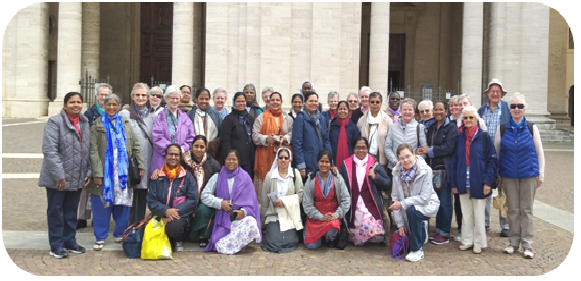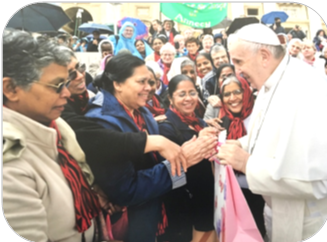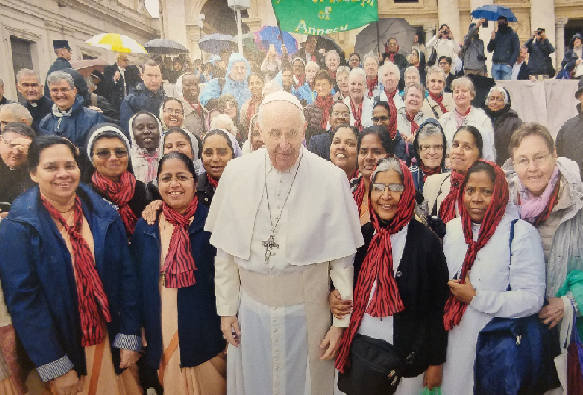CONGREGATIONAL SAFEGUARDING POLICY
“Conscious that everything is interconnected, and we are all interdependent, we are invited to a greater consciousness of our responsibility both with respect to the Charism and its creative transmission.” (General Chapter Orientations 2019)
We, the Sisters of St. Joseph of Annecy, are committed to the safety and welfare of children and vulnerable adults in each and every circumstance and situation.
We believe that every human life is sacred from the moment of conception until its natural end, and that it is God who calls each and every person into a special relationship with God. Accordingly, we recognise that every human being irrespective of age or circumstance, should be afforded the dignity and respect due to a child of God and we recognise the uniqueness of every human life. These belief and fundamental principles are echoed by our founder, Fr. Jean Pierre Medaille, in our Congregational documents:
Constantly enriched with the fullness of Trinitarian love, we dedicate our lives to passing on this gift to all those to whom the Congregation sends us. (Constitutions. #38)
As Sisters of St. Joseph of Annecy, faithful to the ideal which our Founder, Father Medaille, put before us, we aim to further God’s greatest glory by the exercise of the love of God and our neighbour.” (Primitive Rule)
The Sisters of St. Joseph of Annecy are present in 10 countries across the world – France; India; Ireland; Kenya; Tanzania; The Congo; The Gambia; Senegal; Switzerland and Wales. Each Entity has its own Safeguarding Policy, and the Sisters follow the civil, legal, and ecclesial directives laid down in the countries in which they live.
The Congregation is committed to the protection of all children and vulnerable adults in our care and all those with whom we come in contact. We accept that by definition a child is anyone below the age of 18 and a vulnerable adult is someone who “by reason of an impairment or insufficiency of their personal faculties, is not in a position to protect their interests.” (Hague Protection of Adults Convention 2000).
We affirm that any form of abuse is intolerable and not in keeping with our vision and principles, which are based on Gospel values, our Charism, our Congregational texts, and the teachings of the Church in this regard. We recognise that abuse can be carried out in many forms, principally:
- Physical abuse
- Sexual abuse
- Spiritual abuse
- Psychological/ emotional abuse
- Verbal abuse
- Financial abuse
- Neglect
- Abuse incurred via the internet and social media platforms.
- Discrimination
Irrespective of the national or local cultural traditions of where we live and minister, as Sisters of St. Joseph of Annecy we will do everything in our power to ensure that all children and vulnerable adults are kept safe from all that could harm them or deny their innate dignity.
At General Leadership level we will ensure that:
- a designated Sister with responsibility for overseeing Safeguarding is appointed in each Entity of the Congregation and that she receives training and support to fulfil this role.
- each Entity in the Congregation has a Safeguarding Policy, which includes a process for recording and reporting any incidents of abuse.
- Entity policies are to be reviewed and updated regularly.
- each Sister is fully aware of the Safeguarding Policy of her Entity and knows the process for reporting incidents of abuse.
- every January, each Entity will submit to the Generalate a copy of their Recording and Reporting document from the previous year, even if it is a nil return. These documents are to be kept on file in the Generalate.
- all Sisters recognise there is a distinction between a vulnerable adult and an adult who, at certain times, may be in a” vulnerable situation”. In this respect all women in Formation are treated in the same way as vulnerable adults in line with the Congregation’s Safeguarding values and principles.
- anyone reporting a Safeguarding concern or incident of abuse (in some cultures called a “whistle-blower”) is treated with respect and in an atmosphere of confidentiality.
- before a collaborative ministry in entered into, the Major Superior of that Entity, will ensue that the other Congregation or organisation has a Safeguarding Policy in place. This is one criterion for entering into a collaborative ministry.
- Safeguarding procedures are reviewed during the Formal Visitation of communities.
All Sisters of the Congregation are required to live in accordance with this document.
The Congregational Safeguarding Policy was adopted by the Superior General and Council on 15th March 2024. It will be reviewed no later than 14th March 2027.
Sr. Breda Gainey Sr. Vianney Thanniath
Superior General Assistant Superior General
Sr. Margaret Gallagher Sr. Jacqueline Bianquinch
General Councillor General Councillor
Sr. Elizabeth Puthiyedath
General Councillor
Meeting of Neighbours
at Thônes community, 18 September 2021
After the long period of confinement and "sanitary barriers", we suggested, as a community, to meet our neighbours in the courtyard in front of our house.
This desire was mainly to get to know each other in a joyful way around a Canadian meal. We distributed a beautiful invitation in all the mailboxes, made with the help of Christian, a computer expert.
In the sense of sharing and the tradition of the Canadian picnic, we asked that everyone bring something: salads, cheese, food both salty and sweet, drinks etc. Sister Monique coordinated the choices.
The day arrived. Christian and Claudette set up the tables and benches in the courtyard, while others prepared the layout for the aperitif. Then it’s time to share! 25 people arrived with food or drinks for the sharing. The sisters came out to greet the arrivals. There were 35 of us in all. Several people had said they were sorry they could not be there.
During the aperitif, we were already getting to know each other, moving towards each other in joy and under a bright sun!
At coffee time, a couple made all of us sing along with Fr. Dominique in a joyful atmosphere.
Then, as all good things must come to an end, we had to finish this beautiful meeting. Before leaving, several people took part voluntarily in the tidying up in joy.
All said before leaving: Thank you and See you again!
Sisters Monique and Raymonde

Feast of the Immaculate Conception : 8th December 2020
My Dear Sisters,
Special greetings to each of you from myself and the General Team on this the feast of the Immaculate Conception. May each of you be truly blessed by the Blessed Virgin on this her feast day. As Sisters of St. Joseph we are invited by our founder to commemorate this feast when the mother of Jesus was graced by God to lead a life of holiness, free from sin. Fr. Medaille suggested that we would set aside three days of recollection in order to pray to Mary to obtain from her Son Jesus, our deepest desires for holiness an ardent zeal for the salvation of the neighbour and a great purity of intention in all our conduct.” (Spiritual Directory).
The Feast of the Immaculate Conception centres on the belief that Jesus's mother, the Virgin Mary, was conceived without sin. Pope Pius IX issued an apostolic constitution, known as the Ineffabilis Deus, on December 8, 1854. This document clarified the importance of the Immaculate Conception in the Catholic Church.
On the feast of the Immaculate Conception last year, Pope Francis prayed that this feast might help us to make our whole life a “Yes” to God and a “yes” made to adoration of Him and of daily gestures of love and service. Little did we know then how the year would unfold and how we would be challenged to use our love and service whilst thinking and reflecting on this in the wider context.
How has our “yes” been tested during this world pandemic? The global coronavirus pandemic, which has brought death to hundreds of thousands, serious illness to millions more, and financial hardship to the whole world, also poses profound spiritual questions and real challenges to us as Sisters of S. Joseph and indeed to all Christians. In the last few months here in Annecy the virus – Covid 19 -came to our Home in Vieugy. It claimed the lives of at least 15 residents and several sisters and priests. It was a fundamental test of our faith in God and in God’s Providence, and we find ourselves invited to re-examine our relationship with God and with the planet on which we live. These sisters who died are among the many who have gone before us and on whose shoulders we stand. You are familiar with the song:
“Standing on the Shoulders of the Ones who came before us”
We are standing on the shoulders of the ones who came before us,
We are stronger for their courage; we are wiser for their words....
We imagine a world (a Congregation) if they hadn’t tried...
We wouldn’t be gathered here today. …………..”
These Sisters said their “yes” not knowing how it would unfold. Mary said her “yes” as a young Jewish woman within her context. Our sisters who died here also said their “yes” to Gods plan. What is our context in the 21st Century?
Each one of us is unique and created and called for a purpose. Each one of us is called to Mission. John Henry Newman wrote that everyone who breathes has a mission and a purpose on this planet. What is yours?
We are living through turbulent times and in his most recent Encyclical, Fratelli Tutti, Pope Francis challenges us to love outside the box. That we become one human family with rights which are respected……He wants our love to cross boundaries and to reach out to those of other faiths and beliefs, putting an end to war and violence of every kind… This was so clearly seen in the Elections in USA where the president elect used the same sentiments when he invited his people to come together, to act as one and to stop treating each other as enemies.
Turning to the Gospel, Pope Francis said that God thought of Mary and wanted her “from the beginning”. But, he said, in order to be “full of grace”, to be filled with God’s love, it is necessary to listen to God’s Word and trust totally in His will, as Mary did.
Mary, Pope Francis said, “does not lose herself in logical arguments, she does not place obstacles in the Lord’s way, but she promptly entrusts herself and leaves room for the action of the Holy Spirit”, corresponding perfectly to God’s plan for her.
What is God’s plan for us during this time of pandemic? It is easy, though painful, for us to see the growing fragility of our society and our planet. It has been hard for the Sisters in the French Delegation to stand by helplessly and watch several of their loved companions become victims of the virus. It is also hard for some entities to say farewell to those who have come to the end of their natural lives. May they all rest in peace. We are challenged within our Congregation at this time and it is one of the many reason why we have undergone a Congregation study. This Study calls us to think as one to act as one……All is One…..This vision has far reaching effects on all Entities - to open our hearts rather than close them and to be willing to change what needs to be changed, to let go of what we no longer need….. So yes, we have our own struggles within our own contexts and we are invited, like Mary, to say “yes” to the unknown and to remain ever open and receptive to the Spirit of God in our lives. In this circular I am inviting you to rethink your relationships with each other, and your relationship with the planet we live on.
Pope Benedict has something to say to us about the choices we make. He spoke passionately about the planet on which we live saying…” we discover that not only the natural but also the social environment – the habitat we fashion for ourselves – has its scars; wounds indicating that something is amiss. Here too, in our personal lives and in our communities, we can encounter a hostility, something dangerous; a poison which threatens to corrode what is good, reshape who we are, and distort the purpose for which we have been created. Examples abound, as you yourselves know. Among the more prevalent are alcohol and drug abuse, and the exaltation of violence and sexual degradation, often presented through television and the internet as entertainment.
Dear friends, life is not governed by chance; it is not random. Your very existence has been willed by God, blessed, and given a purpose (cf. Gen 1:28)! Life is not just a succession of events or experiences, helpful though many of them are. It is a search for the true, the good and the beautiful. It is to this end that we make our choices; it is for this that we exercise our freedom; it is in this—in truth, in goodness, and in beauty—that we find happiness and joy”.
We are called to relationships of love through our charism. Are we, as Sisters of St. Joseph, hearing this challenge with open hearts and living it or do we think this challenge is for someone else.? If we allow our relationships with each other to be blighted in any way, by our individualism , by our devotion to digital devices e.g. mobile phones and computers, or over use of TV, or if we make choices to relate only outside our communities, how are we going to hear each other? How can we expect to be there for each other at crucial times if we are not present in the first place….So as we rethink our “yeses” within our own contexts, as we rethink our relationships with each other and the planet on which we live, let us look again at our situation and context with new eyes. Let us be open and receptive to grace this Advent. As we await the birth of Jesus, may each one of us, like Mary, be filled with the blessings we need.
I take this opportunity to wish you all the blessings of this great feast and a peaceful and reflective Advent.
With every blessing and prayer,
Sr. Breda 
Editorial
Dear Sisters,
This year, 2019, has been a very important one for our Congregation as each Entity held its Chapter or Assembly in preparation for our 21st General Chapter which took place in Nemi in May. The preparatory work which you had done in the preceding year, your conviction statements and the posters containing each Sister’s photograph, led us to truly feel your presence and inspired us as we worked together in responding to the challenge of the questions: Who are we together? Who is God calling us to be? What is God calling us to do? We realised that something new was emerging within us and among us and that we were working as one body, moving from “I” to “We”. We felt that we were looking at ourselves and our place in creation through a new lens and that a new consciousness was being created.

Visit to Assisi
During our four weeks in Italy we had only two free days and it was arranged that we would go together to Assisi and then to Rome during the following week. On 15th May we had the privilege of meeting Pope Francis and of having our photograph taken with him. We gave him a copy of In the Footsteps of Fr. Medaille by Sr. Gerard, Visakhapatnam Province. He thanked us, gave us rosary beads and asked us to pray for him. It was an experience which we will remember and cherish always.
As this new phase in the life of our Congregation begins and a new General Leadership Team take up its mandate, I would like to thank each one of you for the love and support you have shown during the last six years. In 2013 the theme, “All is One”, inspired us to think about all that unites us as Sisters of St. Joseph of Annecy who live and work in eleven different countries. As we came to know each other better through visits, letters, photographs and social media we became even more aware of the family spirit which exists throughout the Congregation. I would like to think that the setting up of our Congregational website www.srsofstjosephofannecy.org and the articles and news which have been shared in “From One Continent to Another”, have helped us to come to this better knowledge and understanding.
I take this opportunity to thank the Sisters who have helped to produce the Newsletter – especially Sisters Mary Francis, Marie Roland and Maria Goretti and our translators, Sisters Thomasina who has now “retired”, Ellen and Anne Rutter. A big “Thank You” too, to all who have contributed articles over the years. I hope that many more will also be encouraged to share their news and stories.
Sisters let us pray for one another as continue our journey into the emerging future.
Affectionately in Jesus
Sr.Pauline Adampukulam

Sr Pauline presents the book to Pope Francis

Pope Francis asked us to pray for him

